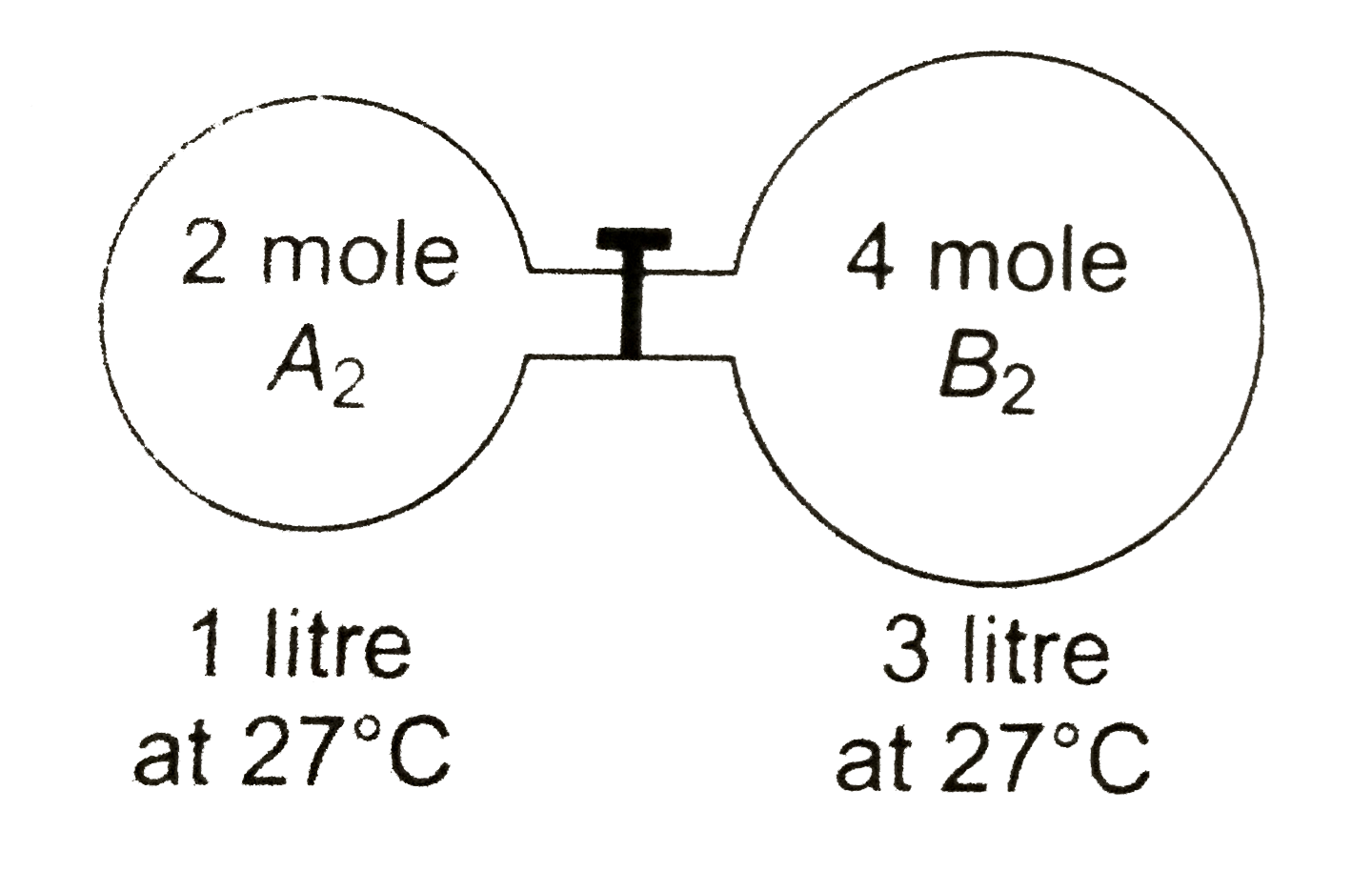
The gas A2 in the left flask allowed to react with gas B2 present in right flask as A2(g)+B2(g)⇔2AB(g),Kc=4 at 27∘C. What is the concentrartion of AB when equilibrium is established ?Solution in Telugu
1.33 M
2.66 M
0.66 M
0.33 M
The correct Answer is:C
Step by step video & image solution for The gas A_(2) in the left flask allowed to react with gas B_(2) present in right flask as A_(2)(g)+B_(2)(g)hArr2AB(g),K_(c)=4 at 27^(@)C. What is the concentrartion of AB when equilibrium is established ? by Chemistry experts to help you in doubts & scoring excellent marks in Class 11 exams.
Updated on:21/07/2023Topper's Solved these Questions
- CHEMICAL EQUILIBRIUMBOOK - NARENDRA AWASTHICHAPTER - CHEMICAL EQUILIBRIUMEXERCISE - Level 1 (Q.93 To Q.122)
1 Videos
- CHEMICAL EQUILIBRIUMBOOK - NARENDRA AWASTHICHAPTER - CHEMICAL EQUILIBRIUMEXERCISE - Level 2
1 Videos
- ATOMIC STUCTUREBOOK - NARENDRA AWASTHICHAPTER - ATOMIC STUCTUREEXERCISE - level 2
1 Videos
- DILUTE SOLUTIONBOOK - NARENDRA AWASTHICHAPTER - DILUTE SOLUTIONEXERCISE - Level 3 - Match The Column
1 Videos
Similar Questions
An equilibrium mixture at 700 K of 0.05M N2(g)and0.2MNH3(g) is present in a container .Now if this equilibrium is disturbed by adding N∘ (g) so that its concentration becomes 0.15M just after addition then which of the following graph represents the above situation more appropriately:
View SolutionCalculate ΔrG for the reaction at 27∘C
H2(g)+2Ag+(aq)⇔2Ag(s)+2H+(aq)
Given : PH2=0.5 bar, [Ag+]=10−5M,
[H+]=10−3M,ΔrG∘[Ag+(aq)]=77.1kJ/mol
View SolutionA small particle of mass m moves in such a way that the potential energy U = ar2 where a is a constant and r is the distance of the particle from the origin. Assuming Bohr's model of quantization of angular momentum and circular orbits, find the radius of nth allowed orbit.
View SolutionColumn -I and Column -II contain four entries each. Entries of column-I are to be matched with some entries of column-II. One or more than one entries of column-I may have the matching with the same entries of column-II.

View SolutionThe value of K_(c) for the reaction: A_(2)(g)+B_(2)(g) hArr 2AB(g) at 100^(@)C is 49 . If 1.0 L flask containing one mole of A_(2) is connected with a 2.0 L flask containing one mole of B_(2) , how many moles of AB will be formed at 100^(@)C ?
View SolutionThe equilibrium constant of the reaction A_(2)(g)+B_(2)(g) hArr 2AB(g) at 100^(@)C is 50 . If a 1-L flask containing 1 mol of A_(2) is connected to a 2 L flask containing 2 mol of B_(2) , how many moles of AB will be formed at 373 K ?
View SolutionThe K_(c) for A_(2(g))+B_(2(g))hArr2AB_((g)) at 100^(@)C is 50 . If one litre flasks containing one mole of A_(2) is connected with a two litre flask containing 2 "mole" of B_(2) , how many mole of AB will be formed at 100 ^(@)C ?
View SolutionThe equilibrium constant of the reaction A_(2)(g)+B_(2)(g)hArr2AB(g) at 100^(@)C is 50. If a one litre flask containing one mole of A_(2) is connected to a two litre flask containing two moles of B_(2) , how many moles of AB will be formed at 373 K ?
View SolutionDeterminre the value of equilibrium constant (KC) for the reaction
A2(g)+B2(g)⇔2AB(g)
if 10 moles of A2 ,15 moles ofB2 and 5 moles of AB are placed in a 2 litre vessel and allowed to come to equilibrium . The final concentration of AB is 7.5 M:
View SolutionThe gas A_(2) in the left flask allowed to react with gas B_(2) present in right flask as A_(2)(g)+B_(2)(g)hArr2AB(g),K_(c)=4 at 27^(@)C. What is the concentrartion of AB when equilibrium is established ?
View Solutionअभिक्रिया A2(g)+B2(g)⇔2AB(g) के लिए 100∘C पर साम्य शिरांक का मान 50 है। यदि एक मोल A2 युक्त एक लीटर के फ्लास्क को 2 मोल B2 युक्त दो लीटर के फ्लास्क से संयुक्त किया जाए तो 73K पर AB के कितने मोल बनेगे ?
View SolutionA_(2)(g)+B_(2)(g)hArr 2AB(g), equilibrium constant of the given reaction at 100^(@)C is 50. A 1 L flask containing 1 mol of A_(2) is connected to a 2L flask containing 2mol of B_(2) . Calculate theno. Of moles of AB at 100^(@)C at equilibrium.
View SolutionThe equilibrium constant (Kc) of the reaction A2(g)+B2(g)→2AB(g) is 50. If 1 mol of A2 and 2 mol of B2 are mixed, the amount of AB at equilibrium would be
View SolutionWhen A_(2) and B_(2) are allowed to react, the equilibrium constant of the reaction at 27^(@)C is found (K_(C)=4).A_(2)(g)+B_(2)(g)hArr 2AB(g) What will be the equilibrium concentration of AB?
View SolutionDeterminre the value of equilibrium constant (KC) for the reaction
A2(g)+B2(g)⇔2AB(g)
if 10 moles of A2 ,15 moles ofB2 and 5 moles of AB are placed in a 2 litre vessel and allowed to come to equilibrium . The final concentration of AB is 7.5 M:
View Solution
The gas A2 in the left flask allowed to react with gas B2 present in right flask as A2(g)+B2(g)⇔2AB(g),Kc=4 at 27∘C. What is the concentrartion of AB when equilibrium is established ?
View Solution
